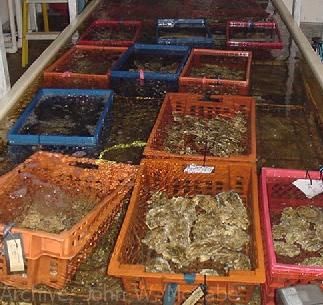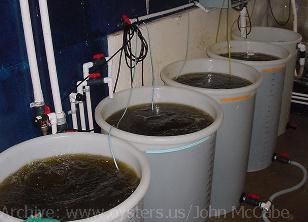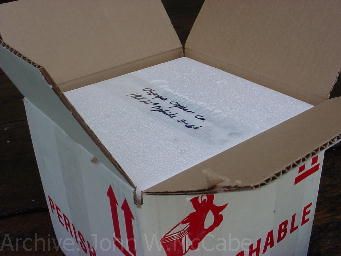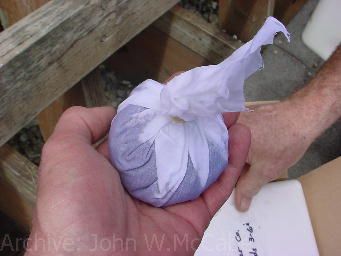Remote Setting (Part 1)
John W. McCabe
The term remote setting describes the act of procurement
of competent bivalve larvae, especially oyster larvae, and inducing
their metamorphosis elsewhere.
Typically, a shellfish hatchery will raise bivalve larvae all
the way up to the eyed pediveliger stage (footed larvae
with "eye spots"). Such larvae are deemed ready to
attach temselves to some surface (i.e. deemed competent
or ready to set). Hatcheries will then sell some or all
of such larvae to shellfish growers who make necessary preparations
at their facilities to then take the larvae to the next developmental
stage. It's a win-win situation. The shellfish hatchery is relieved
of any further growing expense and risk. In turn, shellfish grower
are able to buy immense numbers of larvae at a modest price.
The larvae of several commercially important
bivalve species lend themselves to remote setting, most notably
oyster larvae and, to a much lesser extent, clam larvae. What
follows is a description of remote setting with Pacific (or Japanese)
oyster larvae (Crassostrea gigas). Remote setting of larvae
of other bivalve species can be (in most cases is) more demanding.
Although remote setting has been essential
in sustaining very high oyster production levels of Pacific oysters
on the U.S. and Canadian West Coast for decades, the outcome
of a remote setting effort by a grower is never predictable.
Even the most experienced grower faces uncertainties.
As such, remote setting adds to the fact that
nothing is, or ever has been, easy in the oyster business.
Since it all starts at a shellfish hatchery,
let's go there first.
Welcome to "Whoville"
A shellfish hatchery is a surreal place. Quadrillions of marine
organisms live here together, silently, in a space that typically
measures less than a soccer field. Most are invisible. Many millions
of microalgae can fit in a thimble and several million shellfish
larva can easily be carried in the palm of one's hand. Somehow,
Dr. Seuss' Whoville comes to my mind.
The low, monotonous whir of pumps harmonizes well with the hum
of lighting ballasts. Many water receptacles of varying shape
and size chime in discreetly with burbling sounds. The air tastes
moist and fresh and the temperature is comfortable. There are
no seasons here. Everything looks tidy and clean. To the casual
visitor, this world seems intriguing and somewhat surreal. Closer
study, however, exposes brutal realities. If someone turns off
the electrical supply, all of this "marine Whoville"
will very soon cease to exist. The threat of death by starvation,
disease, water quality issues (e.g. acidification, pollution)
or equipment malfunction is omnipresent - 24/7.
Surprisingly few humans operate this place. In a pinch, as few
as two or three competent people could work hard to keep this
huge menagerie of fragile plants and animals alive.
The underlying principle of a commercial shellfish hatchery is
simple: grow enough microalgae to feed enough bivalve larvae
that will turn into enough seed that will satisfy the requirements
of enough shellfish growers to generate enough hatchery income
to justify its existence. Clearly, the problem-word in that absurdly
long sentence is "enough". For example, what quantities
of what species of microalgae (aka phytoplankton) at what
stage of development are enough to make 1 billion oyster larvae
in an early stage of development happy? Some hatcheries grow
more than 20 different microalgae species to make sure that every
bivalve species raised is assured its special daily "phyto-cocktail".
What if thousands of liters of one microalgae species culture
suddenly "crash"? A "crash" describes sudden
death of microalgae cultures due to one or more reasons. It can
happen overnight (as I have learned the hard way with my small
algal cultures at home). A hatchery is usually prepared for such
crashes by growing enough microalge to offset  such
a loss. I could easily list twenty more risks in a hatchery operation,
some far greater than "phyto crashes". However, this
would lead us too far away from the topic of remote setting.
For now, suffice it to say that operating a shellfish hatchery
can be an exceedingly expensive and risky business.
such
a loss. I could easily list twenty more risks in a hatchery operation,
some far greater than "phyto crashes". However, this
would lead us too far away from the topic of remote setting.
For now, suffice it to say that operating a shellfish hatchery
can be an exceedingly expensive and risky business.
Inset image: Microalgae (or phytoplankton) growing containers
(so called reactors). The green algae in the foreground
is unknown to this writer (most algae species in shellfish hatcheries
are green). The golden-brown algae in the background is likely
a dense batch of the species Isochrysis galbana, certainly
a shellfish hatchery favorite. Click image to enlarge.
Shellfish hatcheries for American oysters (aka Eastern oysters;
C. virginica) date back to fledgling beginnings in the
1920s.
 Inset
image: A news blurb touting The Pedigreed Oyster in the
Reading Eagle, March 18, 1927 (found in Google News Archive).
Inset
image: A news blurb touting The Pedigreed Oyster in the
Reading Eagle, March 18, 1927 (found in Google News Archive).
Pioneering work in successfully completing
oyster development from a larval to early post-larval state in
volume in a closed, controlled environment on a small scale can
principally be attributed to W. F. Wells (1920 ) and H. F. Prytherch (1924
) and H. F. Prytherch (1924 , 1937
, 1937 ). They built on and completed the remarkable research
of W. K. Brooks (1891
). They built on and completed the remarkable research
of W. K. Brooks (1891 )
and others. Large scale, reliable hatchery production of larval
to post-larval oysters (C. virginica) was not perfected
until the 1960s. Although Paul S. Galtsoff
)
and others. Large scale, reliable hatchery production of larval
to post-larval oysters (C. virginica) was not perfected
until the 1960s. Although Paul S. Galtsoff and Victor Loosanoof
and Victor Loosanoof are usually associated with this success,
there were numerous other naturalists that greatly contributed
as well. In the 1970s, shellfish hatcheries rapidly expanded
from the U.S. East Coast to also include the North-American West
Coast. Since then, many more shellfish hatcheries have been built
worldwide. In 1979, a detailed account of the history of shellfish
hatcheries titled Oyster Seed Hatcheries on the U.S. West
Coast: An Overview was furnished by J. W. Clark and R. D.
Langmo.
are usually associated with this success,
there were numerous other naturalists that greatly contributed
as well. In the 1970s, shellfish hatcheries rapidly expanded
from the U.S. East Coast to also include the North-American West
Coast. Since then, many more shellfish hatcheries have been built
worldwide. In 1979, a detailed account of the history of shellfish
hatcheries titled Oyster Seed Hatcheries on the U.S. West
Coast: An Overview was furnished by J. W. Clark and R. D.
Langmo.
Some large shellfish growers operate their
own hatcheries to insure their stocking needs and sell surplus
seed to other, typically smaller shellfish growers. Various universities
also maintain sophisticated hatchery operations. Although such
hatcheries usually focus on research and training, some are capable
of producing commercial quantities of seed.
Most growers either can't afford or don't care for the risks
involved in running a hatchery. However, a great number of North
American oyster growers, most notably on the U.S. and Canadian
West Coast, and also some clam growers, dare to short-circuit
the typical hatchery grow-out from sensitive bivalve larvae to
seed. They buy a hatchery's larvae in vast quantities and do
the rest themselves. In fact, U.S. West Coast demand for oyster
larvae has, for decades, been so great, that it can be feasible
to specialize a shellfish hatchery operation on oyster larvae.
The oldest and most famous hatchery of this type in the world
is the Whiskey Creek Shellfish Hatchery in Tillamook, Oregon,
USA. (view a short YouTube film by clicking HERE).
Spawning at the hatchery
As noted above, this example of remote setting focuses on Pacific
(or Japanese) oysters (C. gigas). Most shellfish hatcheries
keep so called brood-stock on hand. The term describes a relatively
small number of mature bivalves that have been selected as likely
to produce offspring with characteristics that  are desirable in the shellfish industry. The most
obvious such desires are rapid growth, good meat weight, sound
shells and a hardy constitution. It has long been known that
among bivalves, all things being equal, a few develop better
(from a subjective, commercial perspective) than others. Those
few individual bivalves are candidates for hatchery brood-stock.
Selective breeding of Pacific and Eastern oysters has been diligently
studied and applied for decades. In terms of the Pacific oyster,
the biggest name in brood-stock research on the North American
West Coast (and quite possibly the world) is the Hatfield Marine
Science Center, Oregon State University in Newport, Oregon, USA.
are desirable in the shellfish industry. The most
obvious such desires are rapid growth, good meat weight, sound
shells and a hardy constitution. It has long been known that
among bivalves, all things being equal, a few develop better
(from a subjective, commercial perspective) than others. Those
few individual bivalves are candidates for hatchery brood-stock.
Selective breeding of Pacific and Eastern oysters has been diligently
studied and applied for decades. In terms of the Pacific oyster,
the biggest name in brood-stock research on the North American
West Coast (and quite possibly the world) is the Hatfield Marine
Science Center, Oregon State University in Newport, Oregon, USA.
Unlike spawning in a natural setting, a hatchery does not depend
on environmentally favorable circumstances. Instead, it creates
such necessary circumstances whenever needed. Their brood-stock
spawns when directed to do so by the hatchery operators. There
are several ways to "convince" bivalves that the time
for spawning has come (e.g. sudden water temperature increase,
artificially introducing gametes into the water).
As described earlier in this report (see Four-Groups),
the probable outcome of an oyster-spawning event is fertilized
eggs and subsequent oyster larvae - ideally, many millions of
them. In hatcheries, these oyster larvae can take two routes.
Some will stay in the hatchery and will be reared further into
seed. Others will be sold, as mature larvae, directly to growers.
 Inset image (click to enlarge): Oyster larvae rearing basins.
The contents look like huge batches of some brown bouillon soup.
Each basin contains several million larvae. Very close inspection
with the naked eye faintly reveals some movement.
Inset image (click to enlarge): Oyster larvae rearing basins.
The contents look like huge batches of some brown bouillon soup.
Each basin contains several million larvae. Very close inspection
with the naked eye faintly reveals some movement.
When it is time to fill an order from a
shellfish grower, the hatchery operators filter batches of fully
developed ("footed" and "eyed") oyster larvae
from the water in their rearing basins. There are various ways
to strain and count all these larvae. Even coffee filters have
been used at times in the straining process of bivalve larvae.
The larvae can then be centered on a small, porous fabric square
that sometimes looks as if cut from an ordinary white bed sheet.
The sides of the fabric square are then turned
up, bunched at the top and banded, thus rendering a larvae package
in the shape of a little ball. Such a ball with two million oyster
larvae measures about the size of a golf ball. Once this procedure
is done, time is of the essence. The larvae, now out of water,
must stay moist and cool. Depending on the grower's order, one
or several of these balls may have to be shipped promptly at
the same time. In a small, Styrofoam lined box, the larvae balls
are then bedded on all sides in moist paper towels or newspaper,
along with one or more small cooling packs. A reliable overnight
courier company then transports the larvae to the oyster grower.
 Arrival
of Larvae at a Grower
Arrival
of Larvae at a Grower
The inset image shows an example of the aforementioned shipping
box of larvae. In this case, it came from the Whiskey Creek Shellfish
Hatchery in the State of Oregon and was delivered promptly by
a Federal Express man at 1200 hours Pacific Standard Time at
the famed Olympia Oyster Company in the State of Washington.
It has been properly labeled on the lid of the Styrofoam box
liner with the buyer's name and the quantity of "18 x 10 , diploids,
3 - 6's". The first part of the label's lower text, highlighted
with a red square in the inset image, indicates the total amount
of larvae in this shipment. The timely Federal Express man can
now easily trump
, diploids,
3 - 6's". The first part of the label's lower text, highlighted
with a red square in the inset image, indicates the total amount
of larvae in this shipment. The timely Federal Express man can
now easily trump  any braggartry among his colleagues by validly claiming
to have, single-handedly, transported eighteen million live oysters.
any braggartry among his colleagues by validly claiming
to have, single-handedly, transported eighteen million live oysters.
Dips and Trips
Next on the labeling, the term diploids is used. Diploid
means, simply put, that these oyster larvae have, like humans,
two sets of chromosomes. From the  practical standpoint of a grower, the
diploid post-larval oysters (i.e. after metamorphosis) are likely
to grow at about the same rate that wild oysters would and, when
reaching maturity, would be able to reproduce. In moderate climates
with a fairly warm summer and fall, the oysters, when preparing
to spawn, would often have a "milky" consistency and
later, after spawning, their meat could seem sunken-in (a temporary
condition called spawned out). Although such meat conditions
are irrelevant to cooked oysters, many half-shell oyster lovers
do not much care for "milky" or "spawned out"
oysters.
practical standpoint of a grower, the
diploid post-larval oysters (i.e. after metamorphosis) are likely
to grow at about the same rate that wild oysters would and, when
reaching maturity, would be able to reproduce. In moderate climates
with a fairly warm summer and fall, the oysters, when preparing
to spawn, would often have a "milky" consistency and
later, after spawning, their meat could seem sunken-in (a temporary
condition called spawned out). Although such meat conditions
are irrelevant to cooked oysters, many half-shell oyster lovers
do not much care for "milky" or "spawned out"
oysters.
Had the label read triploid instead of diploid, the larvae
would have had, simply put, three sets of chromosomes instead
of two. From the practical standpoint of a grower, the triploid
oysters would grow at a considerably faster rate and 99% (or
more) of them would never reproduce. Instead of preparing to
spawn and turning milky, these oysters would just go right on
feeding without investing resources into the production of gametes.
Hence, triploids are unlikely to ever appear "milky"
or "spawned out".
Today, at least half of the C. gigas
larvae produced by shellfish hatcheries worldwide are triploid.
The reader might wonder why any grower would buy diploid larvae
and seed when triploids appear to be so commercially advantageous.
There are a number of reasons that could prompt a grower to choose
triploid oyster larvae or seed over diploid. Some growers appreciate
the potentially substantial natural sets the diploids can produce
in addition to the seed growing and remote setting a grower employs.
After all, it is a well known fact that, for millennia, the extraordinary
fecundity of oysters has been their recipe for survival. One
grower advised that juvenile triploids simply did not survive
on his tideland while diploids did. The principal of a large
U.S. West Coast shellfish growing company recently informed me
of excessively high mortality levels among his three to four
year old C. gigas triploids. Many growers in France have
blamed triploid oysters as the underlying reason for the recent
outbreak of a devastating, herpes-like disease among one to two
year old Pacific oysters in recent years. Some buyers who are
firm adherents of the tenets of organically grown food simply
don't want triploid oysters. They don't believe that mass production
of triploid larvae and seed is natural - and they are correct.
When, not if, oysters achieve a formal organic qualification,
I feel certain that triploid oysters will not be acceptable -
no more than oysters raised on tideland that has been sprayed
with pesticides (a long-standing practice of big oyster growers
on Willapa Bay in Washington State to kill indigenous mud shrimp).
 Tennis
Balls Instead of Golf Balls
Tennis
Balls Instead of Golf Balls
A hatchery that sells oyster larvae can accommodate a
grower that practices remote setting by packing and shipping
various sizes of the aforementioned "larvae balls",
usually in one million larvae increments. By doing so, the hatchery
helps match a grower's remote setting tank size(s). In this example
case, the label reads "3 - 6s", thus indicating that
the shipping box holds three pouches (or "larvae balls")
of six million oyster larvae each. A ball of six million oyster
larvae measures about the size of a tennis ball.  Subsequently, the hatchery had to utilize
a piece of fabric measuring about 24 x 24 cm (~ 9.5 x 9.5 inches)
for each ball. The Olympia Oyster Company operates three large
remote setting tanks. Each tank requires six million larvae for
remote setting.
Subsequently, the hatchery had to utilize
a piece of fabric measuring about 24 x 24 cm (~ 9.5 x 9.5 inches)
for each ball. The Olympia Oyster Company operates three large
remote setting tanks. Each tank requires six million larvae for
remote setting.
William W. Budge
The methodology of shipping lots of little cloth pouches full
of millions of oyster larvae from a hatchery to far-away oyster
growers for remote setting is certainly a great invention, particularly
if one considers that this invention revolutionized U. S. West
Coast oyster cultivation back in the 1970s. I had often wondered
who came up with it.
For online searches of U.S. American patents
and trademarks, the United States Patent and Trademark Office
(https://www.uspto.gov) provides
several powerful search utilities. Most bountiful (and very fast)
patent searches can also be conducted via https://www.google.com/patents.
Thousands of oyster-related U. S. patents exist. The reading
of just a small fraction can easily keep an oyster aficionado
engaged for many hours on end. The mixture ranges from brilliant
ideas to blatant opportunism, devoid of any ingenuity. Someone
hoping to develop or further some new method or design that could
actually be of great value to others might grow discouraged when
trying to navigate this jungle of preexisting patent claims to
avoid potential infringement. Oftentimes, talented attorneys
have applied their formidable wordsmithing skills to the descriptive
language of patents, thereby expanding the coverage of patent
protection to the outermost limits of what might be called "interpretative
clarity". For example, in an excellent report on cultchless
oyster setting back in 1981, the researchers Herbert Hidu, Samuel
R. Chapman and David Dean devoted an interesting paragraph to
the discussion of the associated legal minefield. The paragraph
ends as follows:
"[…] It is literally impossible
to rear a cultchless seed oyster without infringing on someone's
broadly stated patent. Unfortunately, the
remaining problems with rearing cultchless oysters appear
not to be biological, but legal."
It so happens that one of the patents on the production of cultchless
oyster seed lamented in this paragraph, patent # 3,526,209, was
granted to the person who also was granted the unrelated patent
# 3,735,737: William W. Budge. This patent application was filed
Sept. 14, 1970, with the title "Method and Package for Storing
and Shipping Oyster Larvae". The patent describes almost
precisely today's modus operandi of shipping hatchery
larvae to oyster growers - and even includes a drawing of how
to fold the square of cloth around a little pile of oyster larvae
to produce the aforementioned "golf balls". On May
29, 1973, the patent was granted to William W. Budge from Hillsborough,
California. The assignee was Pacific Mariculture, Inc. in Pescadero,
California.
The results of my search of William W.
Budge (commonly called Bill Budge) and Pacific Mariculture suggest
that he was a brilliant and dedicated scientist who served as
the president of said company. Back in the 1960s and 70s, Pacific
Mariculture worked on the cutting edge of marine aquaculture,
primarily in the area of abalone cultivation and secondarily
in oyster cultivation. An online publication titled "ADVANCES
IN THE REMOTE SETTING OF OYSTER LARVAE", prepared by Gordon
and Bruce Jones, funded by the Aquaculture and Commercial Fisheries
Branch of the British Columbia (BC) Ministry of Agriculture and
Fisheries  ,
furnishes some details of Budge's pioneering work in remote setting.
In combination with his according U. S. patent # 3,735,737, I
find it reasonable to honor William W. Budge as the "Father
of Commercial Remote Setting of Oysters".
,
furnishes some details of Budge's pioneering work in remote setting.
In combination with his according U. S. patent # 3,735,737, I
find it reasonable to honor William W. Budge as the "Father
of Commercial Remote Setting of Oysters".
Part 1 Part 2

Footnotes located at the bottom of Part 2

